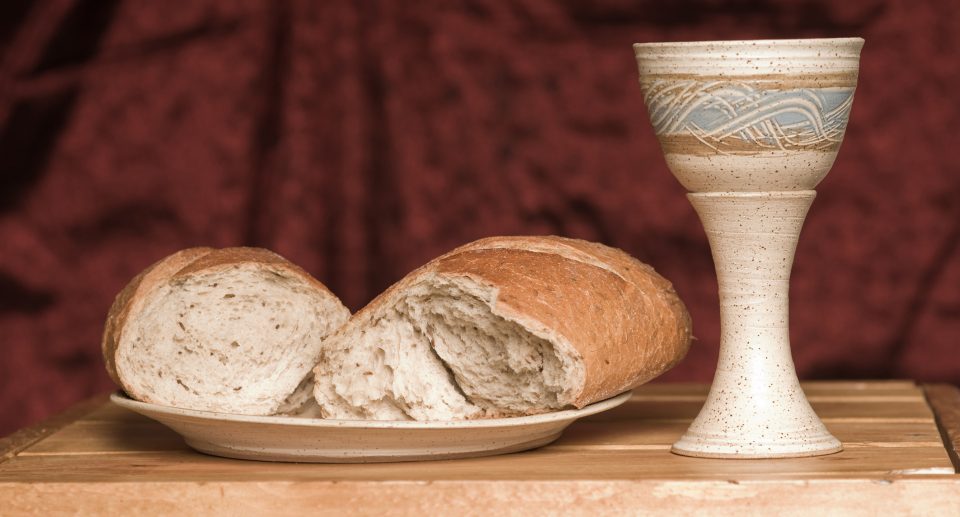What is Holy Communion?
Holy Communion is a sacred meal in which Christ comes to us in bread and wine. “This is my body given for you… This is my blood shed for you.” We believe those words to be true. Christ is truly present in Holy Communion. When we receive the bread and wine of this meal, we receive his body and blood.
What happens in Holy Communion?
Christ comes to us in, with and under the bread and wine to nourish the faith of Christians and the church. We share in a sacred meal that spans all time and space. We commune with the saints who have gone before us and with other Christians around the globe who gather at our Lord’s table. The uncontainable presence, grace, love, forgiveness and mercy of Christ come to us in simple bread and wine.
Who receives Holy Communion?
All of God’s people are welcome to our Lord’s table — it’s our Lord’s table, after all, and all are invited. Let’s be clear — it is not “my” table, or “our” table or a “Lutheran” table. It is our Lord’s table, and he sends out the invitations — to everyone under the sun.
The norm is for baptized Christians to receive the sacrament, as this is a Christian sacrament that nourishes and strengthens faith in Christ. And it is the norm for Christians to receive instruction prior to first receiving the sacrament and to continue to reflect on and learn about the sacrament throughout their Christian life. Surely a few classes during childhood isn’t enough to comprehend the mystery and blessings of Holy Communion, is it? These norms are not iron-clad laws, but they are norms, patterns for how this sacred meal is generally practiced.
There is no minimum age for receiving this sacrament. In years past an age-requirement reflected a desire by the church that those receiving the sacrament examine themselves and understand what it is they were receiving. Now such examination and understanding takes place at a variety of ages and is a part of on-going, life-long education and faith formation.
I generally ask that children express an interest in receiving the sacrament and that they are able to sit through and participate in the worship service before receiving Communion for the first time. First-communion classes are held twice annually, during Lent and in the fall.
How should we receive Communion?
We are to receive these gifts of bread and wine, of Christ’s body and blood, in faith, trusting that in this meal our Lord comes to us, forgives us our sins, renews us in faith and leads us into new life.
The manner of receiving varies in different churches and even within churches, and there is no “right” way to receive. I suggest that people approach reverently — not somberly, but reverently and expectantly — holding out their hand to receive the body of Christ. Then they may take that bread between two fingers and dip it into the cup, dabbing the bread so as to avoid dripping wine on oneself or on the floor, before consuming the bread and wine together.
Upon hearing the words, “Body of Christ, given for you,” and “Blood of Christ, shed for you,” it is appropriate to respond “Amen” or “Thanks be to God.” It is also perfectly appropriate to smile a joyful smile, as this bread and wine are amazing gifts. Some Christians make the sign of the cross before and/or after receiving the bread and wine, as a sign of blessing and remembrance of their baptism. Others may also genuflect or bow before the bread and wine, a gesture that honors the body and blood of Christ and also humbles the one about to receive this great gift of Christ’s holy presence.
What about allergies or other sensitivities to bread and wine?
The church has long taught that Communion with just one element — receiving only bread or only wine — is a valid form of Communion. Yet other forms of food and drink, including gluten-free bread and non-alcoholic drink, are available to congregations and have been the topic of conversation at a recent worship committee meeting and in personal conversations in my office. We will continue to discuss these issues and review our congregation’s Communion practices.
More to say…
There is much more to say about Holy Communion. We can say more about all the prayers and words we traditionally say at the table. We can say more about how ELCA practices of Holy Communion relate to those of other denominations. We can say more about the “how” of Holy Communion — from large chalices to little cups, wafers to pita, altar railings to standing to receive. We can look at what the Bible says about this meal. Clearly, there’s more to say.




